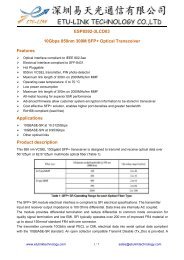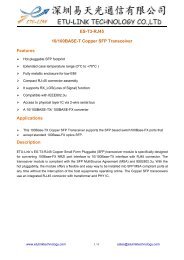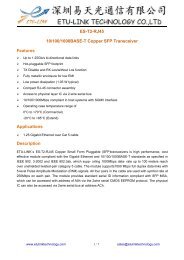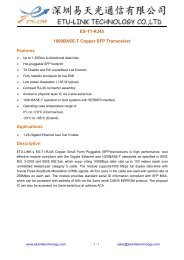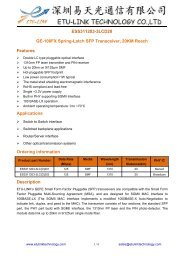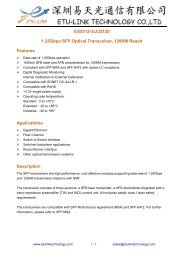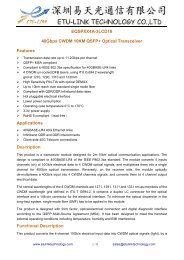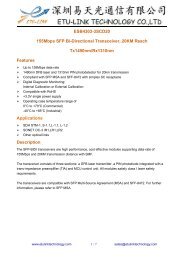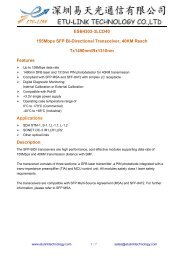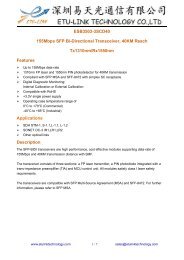EQSP854A-3MCD01
ETU-LINK EQSP854A-3MCD01 are designed for use in 40 Gigabit per second links over multimode fiber. They are compliant with the QSFP+ MSAand IEEE 802.3ba 40GBASE-SR4. The optical transmitter portion of the transceiver incorporates a 4-channel VCSEL (Vertical Cavity Surface Emitting Laser) array, a 4-channel input buffer and laser driver, diagnostic monitors, control and bias blocks. For module control, the control interface incorporates a Two Wire Serial interface of clock and data signals. Diagnostic monitors for VCSEL bias, module temperature, transmitted optical power, received optical power and supply voltage are implemented and results are available through the TWS interface. Alarm and warning thresholds are established for the monitored attributes. Flags are set and interrupts generated when the attributes are outside the thresholds. Flags are also set and interrupts generated for loss of input signal (LOS) and transmitter fault conditions. All flags are latched and will remain set even if the condition initiating the latch clears and operation resumes. All interrupts can be masked and flags are reset by reading the appropriate flag register. The optical output will squelch for loss of input signal unless squelch is disabled. Fault detection or channel deactivation through the TWS interface will disable the channel. Status, alarm/warning and fault information are available via the TWS interface.
ETU-LINK EQSP854A-3MCD01 are designed for use in 40 Gigabit per second links over multimode fiber.
They are compliant with the QSFP+ MSAand IEEE 802.3ba 40GBASE-SR4.
The optical transmitter portion of the transceiver incorporates a 4-channel VCSEL (Vertical Cavity
Surface Emitting Laser) array, a 4-channel input buffer and laser driver, diagnostic monitors, control and
bias blocks. For module control, the control interface incorporates a Two Wire Serial interface of clock
and data signals. Diagnostic monitors for VCSEL bias, module temperature, transmitted optical power,
received optical power and supply voltage are implemented and results are available through the TWS
interface. Alarm and warning thresholds are established for the monitored attributes. Flags are set and
interrupts generated when the attributes are outside the thresholds. Flags are also set and interrupts
generated for loss of input signal (LOS) and transmitter fault conditions. All flags are latched and will
remain set even if the condition initiating the latch clears and operation resumes. All interrupts can be
masked and flags are reset by reading the appropriate flag register. The optical output will squelch for
loss of input signal unless squelch is disabled. Fault detection or channel deactivation through the TWS
interface will disable the channel. Status, alarm/warning and fault information are available via the TWS
interface.
Create successful ePaper yourself
Turn your PDF publications into a flip-book with our unique Google optimized e-Paper software.
protocol activation. The memories are organized as a series of 8-bit data words that can be addressed<br />
individually or sequentially. The 2-wire serial interface provides sequential or random access to the 8 bit<br />
parameters, addressed from 00h to the maximum address of the memory.<br />
This clause defines the Memory Map for QSFP+ transceiver used for serial ID, digital monitoring and<br />
certain control functions. The interface is mandatory for all QSFP+ devices. The memory map has been<br />
changed in order to accommodate 4 optical channels and limit the required memory space. The structure<br />
of the memory is shown in Figure 2 -QSFP+ Memory Map. The memory space is arranged into a lower,<br />
single page, address space of 128 bytes and multiple upper address space pages. This structure permits<br />
timely access to addresses in the lower page, e.g. Interrupt Flags and Monitors. Less time critical entries,<br />
e.g. serial ID information and threshold settings, are available with the Page Select function. The<br />
structure also provides address expansion by adding additional upper pages as needed. For example,<br />
in Figure 2 upper pages 01 and 02 are optional. Upper page 01 allows implementation of Application<br />
Select Table, and upper page 02 provides user read/write space. The lower page and upper pages 00<br />
and 03 are always implemented. The interface address used is A0xh and is mainly used for time critical<br />
data like interrupt handling in order to enable a “one-time-read” for all data related to an interrupt situation.<br />
After an Interrupt, IntL, has been asserted, the host can read out the flag field to determine the effected<br />
channel and type of flag.<br />
For more detailed information including memory map definitions, please see the QSFP+ MSA<br />
Specification.<br />
Figure 2 –QSFP+ Memory Map<br />
www.etulinktechnology.com 6 / 13 sales@etulinktechnology.com




